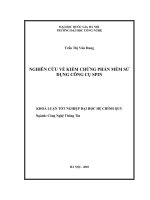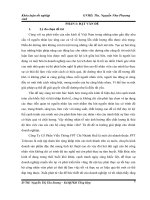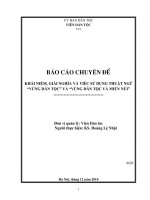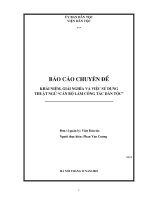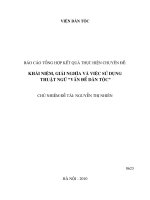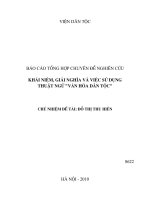khanh ha nghien cuu ve thai do va viec su dung ngon ngu
Bạn đang xem bản rút gọn của tài liệu. Xem và tải ngay bản đầy đủ của tài liệu tại đây (537.51 KB, 99 trang )
MINISTRY OF EDUCATION AND TRAINING
HUE UNIVERSITY OF FOREIGN LANGUAGES
------------
AN INVESTIGATION INTO TEACHERS’
ATTITUDES AND USE OF BODY LANGUAGE
IN TEACHING ENGLISH AT SOME PRIMARY
SCHOOLS IN HUE CITY
MA THESIS IN THEORY AND METHODOLOGY
OF ENGLISH LANGUAGE TEACHING
In partial fulfillment of the requirements for the degree of Master of Arts,
Hue University of Foreign Languages
1
HUE, 2016
2
MINISTRY OF EDUCATION AND TRAINING
HUE UNIVERSITY OF FOREIGN LANGUAGES
------------
NGUYEN TUONG KHANH HA
AN INVESTIGATION INTO TEACHERS’
ATTITUDES AND USE OF BODY LANGUAGE
IN TEACHING ENGLISH AT SOME PRIMARY
SCHOOLS IN HUE CITY
MA THESIS IN THEORY AND METHODOLOGY
OF ENGLISH LANGUAGE TEACHING
CODE: 60.14.01.11
SUPERVISOR: TON NU NHU HUONG, D.Ed.
HUE, 2016
3
BỘ GIÁO DỤC VÀ ĐÀO TẠO
ĐẠI HỌC HUẾ
TRƯỜNG ĐẠI HỌC NGOẠI NGỮ
--------
NGUYỄN TƯỜNG KHÁNH HÀ
NGHIÊN CỨU VỀ THÁI ĐỘ VÀ VIỆC SỬ
DỤNG NGÔN NGỮ CƠ THỂ TRONG VIỆC DẠY
TIẾNG ANH Ở MỘT SỐ TRƯỜNG TIỂU HỌC
TRONG THÀNH PHỐ HUẾ
LUẬN VĂN THẠC SĨ LÝ LUẬN VÀ PHƯƠNG PHÁP
DẠY HỌC BỘ MÔN TIẾNG ANH
MÃ SỐ: 60.14.01.11
NGƯỜI HƯỚNG DẪN KHOA HỌC:
TS. TÔN NỮ NHƯ HƯƠNG
4
HUẾ, 2016
STATEMENT OF ORIGINALITY
This work has not previously been submitted for a degree or diploma in any
university. To the best of my knowledge and belief, the thesis contains no material
previously published or written by another person except where due reference is
made in the thesis itself.
Date: 5/20/2016
Signature
Full name
Nguyen Tuong Khanh Ha
5
ABSTRACT
The research was carried to investigate the teachers’ attitudes and use of body
language in teaching English at some primary schools in Hue city. In detail, the
study was done with 30 teachers at some primary schools in Hue city and the
objectives of the research are to (1) explore teachers’ attitudes towards using body
language in teaching English at some primary schools in Hue city, (2) examine
types of body language employed by them, (3) find out how frequently they were
used and (4) make recommendations for the use of body language in English
teaching classes. Questionnaires, interviews and class observations were used to
collect data. 30 questionnaires were delivered to teachers at some primary schools
in Hue city. 10 teachers were chosen to interview and the observations were done in
5 classes. The major findings show that(1) all of the teachers acknowledged the
importance of body language in English teaching, (2) six types of body language
namely facial expressions, eye contact, gestures, posture, touch, and distance were
used by all of the teachers,(3) the frequency of teachers’ use of body language types
was different and (4) some suggestions were given toward teachers, students,
administrator officers and textbook writers to find more effective ways in teaching
English for primary students.
6
ACKNOWLEDGEMENTS
This project would not have been finished without the help of many people.
First and foremost, I would like to express my deep gratitude to my supervisor
Dr. Ton Nu Nhu Huong who has supported me throughout my thesis with her
patience, motivation and immense knowledge. Actually, her expert guidance and
value feedback at every stage of the development of this study helped my thesis be
improved and completed.
I would like to thank the teachers from primary schools in Hue city for spending
their time to provide me the needed information.
Last but not the least, I am deeply grateful to my parents, my sister and my close
friends for supporting me spiritually throughout writing this thesis and my life in
general.
7
TABLE OF CONTENTS
Contents
Pages
SUB COVER PAGE................................................................................................i
8
LIST OF ABBREVIATIONS
9
NVC
: Non-verbal communication
ELT
: English language teaching
LIST OF FIGURES
10
CHAPTER 1
INTRODUCTION
1.1. Introduction
This chapter presents the rationale, significance, objectives, research questions,
scope and outline of the research.
1.2. Rationale
English playsan important role in human life. It is the global languageand is
spoken by many people in the world. It is used widely in all aspects such as science,
technology, and education. It also creates advantages for people who want to get
good jobs. Hasman (2000) stated, “English may become one tool that opens
windows to the world, unlocks doors to opportunities, and expands our minds to
new ideas” (p.5). Moreover, English can help people communicate and transmit
information among people who have different languages. Being aware of its
importance, Government of Vietnam asked students to learn English as a
compulsory subject from grade 3 (Government of Viet Nam, Decision 1400/QDTTg, 2008).According to Wilburn Robinson (1998), young students who learn a
foreign language at an early stage will demonstrate academic benefits in other areas
of curriculum. Besides, students learning a second language with native speakers
will speak it naturally if they learn it when they are young (Chavez, 2006).
Moreover, Lightbown and Spada (2000) said that it is good to teach foreign
languages at the ages 10, 11, 12. Therefore, it is taught since the early age because
learning English at this stage will be better.
However, when students study English at the early age, they do not have
knowledge of vocabulary to understand what the teachers mean. Yuanyuan (2014)
said that the limitation in vocabulary is one of the reasons making teaching English
for young students not easy, so it requires teachers have effective ways to enhance
their teaching. Children aged 10 to 12 are at critical period for learning English
11
(Lightbown &Spada 2000), but young learners often are distracted and they do not
focus on anything in a long time. Thus, teaching English requires creativity to
attract students’ attention as well as help them acquire knowledge easily. To meet
the need of effective ways for English teaching, Yuanyuan (2014) mentioned one of
the useful and proper ways to help students understand the teachers’ instructions is
using body language. Stevich (1982) stated,
“The body language of a teacher is the most important thing in the class… it is the way you
use your eyes, the distance you stand front of students, the way you touch or refrain touching
them. All of these unnoticeable things in the class very important signals create a profound
effect on your students’ feelings of welcome and comfort with you.”(p.6)
It cannot be denied the necessity of using body language in English teaching,
especially for primary teachers because it is a useful way to transfer knowledge to
children who have limitations on English vocabulary.
In Vietnam, English has been made as a compulsory subject from grade
3(Government of Viet Nam, Decision 1400/QD-TTg, 2008). A pilot of English
teaching program for young learners was implemented from grade 3 (Nguyen,
2011) but English teachers find it difficult to teach it because most primary teachers
are lack of skills to teach young students. They were trained to teach secondary
level or higher (Viet Nam News, 2011). Besides, according to Vietnamnet (2016),
over 50% of primary teachers do not meet language proficiency requirement. This
leads to 24.000 primary English teachers will be retrained by 2018 with the purpose
of developing English proficiency and Teaching English for young students (Pham
& Vu, 2014). For these reasons, finding a proper way or a useful method to help
English primary teachers is necessary. Being aware of the importance of body
language in teaching English for primary students, the author has decided to carry
out the study entitled “An investigation into teachers’ attitudes and use of body
language in teaching English at some primary schools in Hue city”.
1.3. Significance of the research
The research was carried out to find out the teachers’ attitudes as well as the
12
teachers’ use of body language in teaching English for primary students. Besides,
the research provided teachers theory of body language and some suggestions were
given to help teachers know how to apply it well in teaching. Furthermore, it is also
useful for teachers in designing interesting lesson plans to attract students’ learning.
Lastly, it might play a role as an inspiration for further studies on body language,
especially the domain of how to apply it in teaching English for primary students.
1.4 . Objectives of the research
The research was carried out to (1) explore teachers’ attitudes towards using
body language in teaching English at some primary schools in Hue city in order to
consider whether it is a popular way in teaching English for young students, (2)
examine types of body language teachers use in order to recognize which types
teachers often use effectively in teaching , (3) find out how frequently teachers use
them in order to identify how to apply them widely in teaching English at some
primary schools in Hue city, and (4) make recommendations for the use of body
language in English teaching classes in order to help teachers apply it well in
English teaching.
1.5 .Research questions
Based on the objectives of the research, the research questions were raised as
follows:
1. What are teachers’ attitudes towards using body language in teaching English
at some primary schools?
2. What types of body language do they use?
3. How frequently do teachers use them?
4. What are their suggestions for a better use of body language in English
classes?
1.6. Scope of study
Each primary school has only 3-5 teachers and the researcher did not have
13
enough time to investigate with a larger scale, so the research was carried out with
the participation of 30 teachers at some primary schools in Hue city (Tran Quoc
Toan, Phuoc Vinh, Thuy Bieu, Huyen Tran, Phu Binh, Vinh Ninh, Kim Long, Hue
Star, Ly Thuong Kiet and Le Loi). They are both experienced and inexperienced
teachers in teaching English.
Both of the quantitative and qualitative approaches were used. The data was
collected by using questionnaires, interviews and observations. 30 questionnaires
were delivered to teachers at some primary schools in Hue city. The interviews
were carried out with ten teachers and the observations were done with 5 classes at
some primary schools in Hue city.
1.7. Outline of the research
There are five chapters in the thesis. Chapter 1 presented the rationale,
significance, objectives, research questions, scope and outline of the research.
Chapter 2 presented the definitions used in the thesis, theories which the thesis was
based on and presented previous studies. Chapter 3 described the research methods
and data collection. Chapter 4 displayed the findings and discussions. Chapter 5
presented the conclusion, implications for the body language use in English
teaching and some suggestions for further studies.
14
CHAPTER 2
LITERATURE REVIEW
2.1. Introduction
This chapter begins with the first part with non-verbal communication, including
its definition, types and functions. The second part is definition of body language
and its types. The importance of body language in language teaching and
characteristics of young learners are followed. The relationship between attitude
and the use of body language and Vietnamese teachers of English are the next two
parts. Lastly, some related studies are reviewed.
2.2. Non-verbal communication
2.2.1. Definition of non-verbal communication
Body language plays an important role in teaching English because it can convey
meaning to support for teaching, especially for primary students. Body language is
one part of non-verbal communication (NVC); therefore it is based on definition of
NVC. There are many scholars who defined it and gave different points of view
such as Levine and Adelman (1993), Richmond and Mc Croskey (1995), Miller
(1988), Gamble and Gamble (1998), Gregersen (2007) and so on. However, in this
study, the author would like to present three definitions which are suitable to the
content of this study. They are short and understandable definitions and help readers
easily access to understanding of NVC. Three definitions are those of Levine and
Adelman (1993), Richmond and Mc Croskey (1995) and Gamble and Gamble
(1998).
Levine and Adelman (1993) defined NVC as follows:
Non-verbal communication is “silent” communication, including the use of
gestures, facial expressions, eye contact and conversational distance (p. 100)
It can be seen that, this definition is very simple and clear with a general view
of NVC, and its types. General view of NVC of the authors is emphasized when it
15
shows that NVC is “silent”, different from verbal communication when using of
sounds and words to express. One word “silent” shows its specific characteristic
because the word “silent” means “not expressed with words or sounds” (Oxford
dictionary, p. 1368). This definition is clearer when mentioning its types “the use of
gestures,
facial
expressions,
eye
contact
and
conversational
distance”.
Nevertheless, all types are just focused on one aspect that is body language;
therefore the definition seems rather limited.
Another definition is presented by Richmond and Mc Croskey (1995). They
defined NVC as “the process of one person stimulating meaning in the mind of
another person or persons by means of non verbal messages” (p.1). Compared with
the above definition, “silent” word is shown through this definition. However, this
definition will be more specific when mentioning what the meaning of non-verbal
messages is to help readers have a specific view on NVC.
The other is introduced by Gamble and Gamble (1998) as follows:
“Non-verbal communication is [that] form of communication that does not
include words. It is composed of messages that are expressed by non linguistics
means. Indeed, it is the actions or attributes of humans, including their use of
objects or sounds time and space that have socially shared significance and
stimulate meaning in others.” (p.103)
Within this definition, Gamble and Gamble (1998) had a more specific view on
NVC when they defined it from general to specific. Firstly, they defined it is a form
of communication. This helps readers have general understanding of NVC. From
then, they showed its detail of communication by mentioning that communication
does not include words. It can be seen that the phrase “not include words” is similar
to the word “silent” in the definition by Levine and Adelman (1993). Besides, both
Richmond and Mc Croskey (1995) and Gamble and Gamble (1998) shared a similar
point about conveying the nonverbal messages in different phrases “non linguistic
means” and “non-verbal messages”. However, this definition is also limited when it
16
only introduces some aspects of non-linguistic means which are objects, sounds
time and space, not all types of NVC. Compared with the definition given by
Levine and Adelman (1993), it can be seen that the second part “use of objects or
sounds, time and space” in Gamble and Gamble’s definition (1998) and “the use of
gestures, facial expressions, eye contact and conversational distance” in Levine and
Adelman’s definition (1993) can be combined to make readers have a clearer
comprehension in using nonverbal messages of completing their NVC.
Although the three definitions have not fully generalized aspects of NVC, they
provide readers an overview of it. Despite limitations, different use of words, the
author chose Gamble and Gamble’s definition (1998) as the foundation for the
thesis because of its logicality and details as analyzed above. The next section will
focus on the types of NVC.
2.2.2. Types of non-verbal communication
There are a variety of versions given by different scholars about NVC. However,
the author would like to present three main classifications which are well-matched
to the content of the study.
Ruesch and Kees (1956) (as cited in PENG, 2011, p. 508) stated that non-verbal
behavior bases itself on foundational components of NVC: sign language, action
language and object language. This is the earliest classification, so it did not clearly
show what sign language, action language and object language were to apply it in
teaching English.
Knapp and Hall (1997, pp. 12-20) proposed seven categories of non-verbal
communication: body motion and kinesics behavior, physical characteristics,
touching behavior, paralanguage, proxemics, artifacts, and environmental factors.
Gamble and Gamble (1998) proposed 7 categories of NVC:
1.
Kinesics: facial expressions, gestures, eye movements, postures, rates of
walk
17
2.
Paralinguistics: how words are spoken, variations in the voice
3.
Proxemics: how space and distance are used
4.
Haptics: different types of touching
5.
Clothing and artifacts: appearance, styles
6.
Colors: variations in clothing and environmental colors
7.
Chronemics: using time to communicate ( p.107)
Malandro, Barker and Barker (1989) identified the specific classes of non-verbal
communication as follows: (1) body types, shapes and sizes, (2) clothing and
personal artifacts, (3) body movement and gestures, (4) facial expression and eye
behavior, (5) environment, (6) personal space, territory and crowding, (7) voice
characteristics and qualities, (8) taste and smell, and (9) culture and time. It can be
seen that, they divided NVC into nine types and each type gave the readers clear
and detail understanding of its name as well as its characteristics. From
classifications of Gamble and Gamble (1998) and Malandro et al. (1989), although
NVC are categorized with different names, they have the same core composition.
For example, they both mention body (Kinesics) or voice characteristics
(Paralinguistics) in spite of the different arrangement of means of NVC. Despite
some differences in classifying, they are used in the same purpose. They convey the
non-verbal messages in NVC. Nevertheless, the author chose division of Gamble
and Gamble (1998) as foundation for the thesis because body language with its
types was mentioned in this classification.
2.2.3. Functions of non-verbal communication in language teaching and
learning
Early on, Ekman and Frisen (1969) pointed out the functions of NVC such as
repetition, augmentation, elaboration, substitution and contradiction of verbal
message. Besides, NVC also helps manage turn taking in the conversation (Duncan,
1972). In addition to these, NVC creates the right learning environment in the
18
classroom (Mehrabian, 1972).
According to Samovar and Porter (1991, pp. 181-182), NVC serves five primary
functions: repeating, complementing, contradicting, substituting and regulating
complementing
1.
Repeating: repeating what have been said verbally, e.g. you might hold up
your hand in the gesture that signifies “stop” at the same time you actually
use the word “stop”
2.
Complementing: adding more information to the point you are trying to
make verbally, e.g. you can tell someone you are pleased with his/her
performance, but this same message takes on extra meaning if you put the
person on the shoulder , at the same time offering the verbal compliment
3.
Contradicting: contradicting verbal messages, e.g. you tell someone that
you are not nervous, at the same time your hands are tremble, your eyes are
blinking rapidly, and your face is covered with sweet beads
4.
Substituting: replacing verbal messages, e.g. if you see your very special
friend, you are apt throw open your arms to greet him/her instead of saying
“Hi”, “Good day” or the like
5.
Regulating: regulating and managing the communication event, e.g.
when conversing, you nod your head to encourage your partner to continue
talking, or remain silent for a moment to send a message that you are now
ready to begin your speech. Such nonverbal behavior helps control the
situation.
From Samovar and Porter’s definition (1991), it can be seen that functions
presented above included functions of Ekman and Frisen (1969), Duncan, (1972)
such as repetition, substitution, contradiction or turn taking management. Therefore,
it was chosen as a basis for the thesis. Body language will be discussed in the next
part.
19
2.3. Body language
2.3.1. Definition
There are many definitions of body language. Hornby (2006) (as cited in
Yuanyuan, 2014) defined it as follows:
“Body language is a term for different forms of communication using body
movements or gestures instead of, sounds, verbal language, or other ways of
communication. Body language is the process of communicating what you are
feeling or thinking by the way you place and move your body rather than by
words.” (p. 1205).
This definition is quite detailed and clear in describing types and the process of
communication that contains body language. Besides, body language transmits a
message and conveys meaning to the observer through body movement, posture or
facial expressions and every part of the human body was affected byphysical,
social, and cultural context of the action(Blakemore & Jennett, 2007). Both two
definitions mention two aspects of body language, body movements and gestures.
In addition to describing its types, function, physical, social and cultural context of
the action were shown as factors affecting body language.
According to Pirsl and Djordjevic (2012)“Body language is a form of mental
and physical ability of human non-verbal communication which consists of body
posture, gestures, facial expressions, and eye movements” (p.986). This definition
is quite sufficient to gain nature of the issue when mentioning what form of
communication that body language belongs to and showing its types. Each
definition has strengths as well as weaknesses. However, to select a definition
which is suitable to the content of the study as well as to help readers have clear
understanding of it, the author chose Hornby’s definition (2006) (as cited in
Yuanyuan, 2014) as the basis for the thesis. The next section will discuss types of
body language.
2.3.2. Types of body language
20
Many researchers presented different types of body language. Kinesics is the
synonym word of body language. Kinesics includes facial expressions, gestures,
eye movement, postures and rates of walk (Gamble & Gamble, 1998). This
classification is clearly visible but the author would like to present another clearer
definition of Morain (1978) (as cited in Ton, 2002, p.30). According to Morain
(1978), body language is classified into movements, gestures, postures, facial
expressions, gaze, touching and distancing. Types of body language were shown
clearly in both two definitions such as facial expressions, gestures, postures and so
on. However, the Morain’s definition (1978) (as cited in Ton, 2002, p.30) is more
enough when adding “touch” to her classification. Knapp and Hall (1992) also
shared the similar point that body language also includes gestures, posture, touch,
facial expressions, eye behavior. From three above definitions, it can be seen that
Morain’s definition (1978) (as cited in Ton, 2002, p.30) is more detailed than
others. That is the reason why the author chose it as the foundation to classify types
of body language for the study. Facial expressions will be discussed in the next
section.
2.3.2.1. Facial expressions
According to Knapp and Hall (2006),
“The face is rich in communication potential. It is the primary site for
communication of emotional states, it reflects interpersonal attitudes; it
provides nonverbal feedback on the comments of others; and some scholars say
it is the primary source of information next to human speech. For these reasons,
and because of the face’s visibility, we pay a great deal of attention to the
messages we receive from the faces of others.” (p. 260).
From his saying, it cannot be denied that face importantly contributes to
communicating with others through nonverbal feedback. Facial expressions reflect
a whole range of emotions, feelings and attitudes from the deepest to the most
superficial because the face is one of the most reliable indicators of a person’s
21
attitudes, emotions and feelings. Much research has supported the universality of a
core group of facial expressions: happiness, sadness, surprise, fear, anger and
disgust. These emotions are shown by such actions as smiling, frowning, etc. Anger
or confusion can be shown by a frown or wrinkled brow (Neil & Caswell, 1993).
However, a relaxed facial expression (smiling) is a signal of satisfaction with
current environment (Gukas et al, 2010). It is generally good to smile at your
listener from time to time, especially when he or she makes an interesting comment.
A smile makes communication easier.
Facial expressions are a common way to communicate and play a significant
role in teaching and learning. Students will receive exact messages through their
teachers’ facial expressions because hidden feelings are shown through them. When
a student gives a wrong answer, a teacher’s frown can make them correct his
answer immediately (Liangguang, 2011). Students can study comfortably if a warm
smile is given by the teacher (Yuanyuan, 2014). Gestures will be discussed in the
next part.
2.3.2.2. Gestures
Michael (1988) said that “gestures include voluntary bodily actions, by hand,
head or other parts of the body which are intended to communicate” (p.188).
Liangguang (2011) also shared the similar point about gestures as follows: “a
gesture is an expressive motion or action, usually made with the hands and arms,
but also with the head or even the whole body” (p. 906). From Michael (1988) and
Liangguang (2011)’s statements, it can be seen that gestures are used as an intention
to express motion and motion in communication by using hand, head or other parts
of the body.
Gestures can be used to reveal or conceal feelings. Furthermore, they are used to
illustrate points and manage turn taking. However, the meaning of gestures can be
very different across culture. A signal for “Yes” means “No” in another. Therefore,
it is important to be careful to avoid misinterpretation. According to Ekman and
22
Frisen, (1969, pp. 63-96) gestures are categorized into five types: illustrators,
regulators, emblems, affect displays and adaptors. Gesturing, frowning, smiling are
signals of illustrators to illustrate a point. They are used for conveying the same
meaning as the verbal messages. Besides, they supplement in understanding a
teacher’s message for an English language learner. Regulators are the second type
of gestures and they are used to control turn-taking in conversation. When a person
completes what he is saying, he may drop his arm, whilst a person wants to speak
may raise an arm. Emblems are specific gestures that can substitute words to
transmit a message. Holding up the hand with all fingers closed in except the index
and second finger, which are spread apart can mean “V” for victory if the palm is
away from the body. The fourth type is affect displays. They are gestures that can
be used to display emotions. These are actions that are paired with emotions such as
facial expressions like smiling, laughing or crying. Covering or rubbing eyes, ears
or mouth can say “I do not want to see/ hear/ say this”. Finally, adaptors are
gestures that are not used intentionally during an interaction. They reveal attitudes
and feelings such as upset, nervous. Biting one’s nails, adjusting one’s clothes are
its examples. They are made for reasons of comfort. These displays are necessary
for language learners to show their emotions and attitudes.
Effective teachers use gestures to communicate with students, build rapport with
them and make them feel safe and supported. Using gestures, tiny actions can
attract students’ curiosity as well as encourage them to learn. Verbs such as “clap”,
“jump”, and “walk” can be expressed by actions directly. They help students easily
understand instead of teachers repeat their explanation. Consequently, they can
remember them with a deep impression. Gestures are the most important part of
body language. Teachers use them to communicate with students in class and they
can make class lively. Furthermore, communication activities in class are not dull,
dry and they can enliven the teaching circumstances.
It can be seen that gestures have an important role in daily communication as
well as in teaching and learning because it contributes to conveying the meaning of
23
attitudes and feelings. The next part will present eye contact.
2.3.2.3. Eye contact
“Eye is one of the most important nonverbal channels you have for
communication and connecting with other people. The cheapest and most
effective way to connect with people is to look at them into the eye. Eyes are not
only the “window to the soul”, they also answer the critical question when you
are trying to connect: is he paying attention to what I am saying? Does this
person find me attractive? Does this person like me?”
(Ketelnikov, 2006, p.1)
Eye contact has a significance influence in communication. It is a way of
communication attraction. It is a key element in communication. The way you look
at someone can communicate many things and indicate a range of emotions
including hostility, interest and attraction. It is also maintaining the flow of
conversation. There are many factors affecting the amount of eye contact and how it
sends messages such as habit, personality, intimacy, culture, gender and so forth.
However, scholars pay more attention to culture and gender because “Culture and
gender are two highly significant determinants of levels and patterns of social looking”
(Hargie et al, 2004, p.65).
Michael (2010) said that eye contact is a meeting of the eyes between two
individuals. “The eyes are the window to the soul”. It is vivid and it can talk. It is
also the way to transmit messages, exchange feelings, express attitudes between
teachers and students. By using eye contact, teachers can encourage students by
encouraging their eyesight when students do not answer a question for a long time
or making them restrain themselves consciously if they do not concentrate their
attention on lectures by staring angrily at them. However, in addition to making eye
contact with their teacher, they can avoid his eye contact when they are not
interested in the matter (Miller, 2005b).
Eye contact is a significant factor in social communication between humans
24
because it can help people gauge the other person’s response. Besides, it is also vital
to both teachers and learners because it is a powerful tool in managing the
classroom and stirring the atmosphere of the class. In addition to eye contact,
posture is also important and it will be discussed in the next part.
2.3.2.4. Posture
Attitudes and emotions are not only indicated by facial expressions, eye contact,
gestures but also posture. Posture is understood through such indicators direction of
lean, body orientation, arm position and body openness(Peter, 1987, pp. 17-25).
Two forms of posture have been identified “open” and “closed” posture (Verma,
2005). These two forms reflect individual’s degree of confidence, status or
receptivity to another person. Open posture portrays friendship and positivity.
Sitting or standing up straight with your head are signals of open posture. In
contrast, crossing your arms across your chest, sitting in a hunched forward
position, showing the backs of your hands and clenching your fist are all signs of
closed posture. It may give the impression of boredom, hostility and detachment.
Besides, slumping or slouching when seated is an indication of a discouraged state
(Miller, 2005a, 2005b).
Posture also contributes to English teaching. It shows attitudes, emotions as well
as sends a strong message of a teacher. For a teacher, standing or sitting in relaxing
professional manner is a positive posture, which can arouse students’ positive
attitude, and show that you are approachable, receptive, and friendly (Liangguang,
2011).
All people use posture to communicate. It can reflect emotions, attitudes and
intentions. Touch is the next part which will be discussed.
2.3.2.5. Touch
Touch is an extremely important sense for humans as well as providing
information about surfaces and textures (Miller et al, 2010).Touch can be used to
communicate affection, familiarity, sympathy and other emotions. It is the way
25


